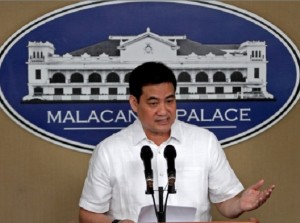No one is starving in Zamboanga evacuation camps—Lacierda
MANILA, Philippines—Malacañang denied Thursday that more than 100,000 people displaced by 11 days of fighting between government forces and Moro National Liberation Front guerrillas in Zamboanga City were going hungry.
Presidential spokesperson Edwin Lacierda reported that the number of evacuees had reached 112,961 people and they were sheltered in 57 evacuation centers in Zamboanga City and in the homes of friends and relatives in other “safer places” on the Zamboanga Peninsula.
“The largest of these centers is the Joaquin F. Enriquez sports complex, also known as the Grandstand, which holds 63 percent of the total number of families inside the evacuation centers,” he said.
Lacierda also released a situation report from the Department of Social Welfare and Development to belie reports of evacuees going hungry.
He stressed that the government was dealing with the needs of the evacuees, and asked for “fair play” and “fair coverage” instead of emphasizing “isolated incidents.”
Article continues after this advertisementOfficials at some of the evacuation camps had earlier on reported they were encountering problems cooking and preparing food for tens of thousands of people. That was before the planned hiring of some of the housewives from one among the evacuees themselves to help in the kitchens.
Article continues after this advertisementLacierda said that the DSWD, through a number of caterers in the city, was providing 70,000 packs of ready-to-eat meals three times a day.
The community kitchen of the City Social Welfare Development Office is also providing food to 12,000 evacuees three times a day, and the Philippine National Red Cross, International Community of the Red Cross, along with the Western Mindanao State University, also cook dinner for 10,000 evacuees every day, Lacierda said.
“Established community kitchens of the DSWD inside the Grandstand are providing [additional food]. The DSWD continues to provide food packs to 613 Badjao families who preferred to stay in their vintas (at sea behind) the Grandstand,” he said.
He said the DSWD was also conducting a computerized profiling of displaced families using the DSWD Disaster Assistance Family Center, family access cards for validation, and profile generation as basis for the provision of relief and other assistance, including shelter for families whose houses were badly damaged or burned in the fighting.
“We’d like to thank the many men and women who have served the evacuees, the men and women of the DSWD, and also the men and women who have volunteered their services to help the evacuees,” Lacierda said.
Related Stories:
Life picks up in Zamboanga as troops corner rebels
